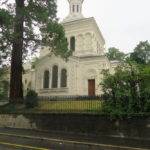The St. Barbara Church in Vevey (canton of Vaud) is a Russian Orthodox parish beloning to the history of the Russian Orthodox Church in Switzerland after 1816.
The first Russian Orthodox parish in Switzerland was established in Bern on 24 December 1816. Tsar Alexander I (1777-1825) had commissioned the building and its consecration.
The Tsar maintained good relations with the young Confederation of 22 cantons, and was also one of its most important advocates at the Congress of Vienna in 1814/1815. One of his most valued advisers was the Swiss Frédéric-César de La Harpe (1754-1838). The parish moved to Geneva in November 1854.
Many Russian aristocrats, artists, students and revolutionaries resided in Switzerland and around Lake Geneva in particular. Many Russian Orthodox churches were built.
The development of tourism and health resorts also attracted a rich clientele. Count Pyotr (Peter) Shuvalov (1827-1889) requested and received permission to build a church in Vevey in memory of his daughter Barbara. Jean-Samuel Késer-Doret (1813-1902) was the architect. The church was consecrated on 1 November, 1878.
(Source and more information about the Orthodox Church in Switzerland: https://orthodoxie.ch).










